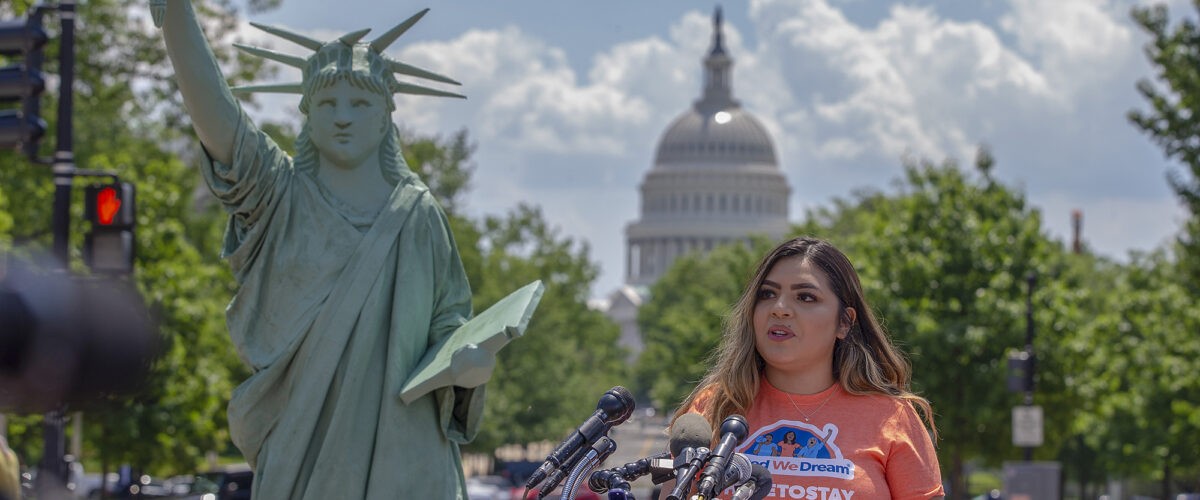Dreamers, their families and the advocates concerned for their protection are marking the 10-year anniversary of Deferred Action for Childhood Arrivals, or DACA, with measured gratitude and rising concern for their futures in the United States.
The program was launched by executive order from President Barack Obama in 2012 as a way to circumnavigate Congress’ inaction on finding a way for undocumented immigrants brought into the country as children to legally drive, pursue education and work without fear of deportation.
But 10 years later — as always for DACA recipients, also known as Dreamers — there are clouds on the not-too-distant horizon.

Samantha Howland Zelaya
“The immigration community and many other communities who support Dreamers are very vocally supportive of finding a permanent solution for DACA, but there also have been consistent legal challenges to DACA throughout its lifetime,” said Samantha Howland Zelaya, assistant vice president of policy and advocacy for the National Immigration Forum.
Partly due to the decade anniversary of the program and partly because highly anticipated legal resolutions are imminently expected, Howland Zelaya recently issued an analysis of DACA that includes an overview of its history and the court challenges it currently faces. The document’s release also coincides with recent heightened efforts by the Forum, the Alliance for a New Immigration Consensus and other immigration advocates to push Congress to enact meaningful immigration reforms, including pathways to citizenship for Dreamers as well as residency protections for migrant essential workers in the U.S.
“DACA has opened up doors for countless Dreamers — but unfortunately, even after 10 years of the program, Dreamers continue to live in perpetual legal limbo,” Howland Zelaya writes. “Because the program was created via executive action and not congressional legislation, DACA could be revoked by further executive action and is subject to legal challenges — with recent court decisions rendering its future uncertain.”
“Despite some legal victories that allowed DACA to stay in place throughout the Trump presidency, recipients currently face a more uncertain future than ever after an adverse decision from Judge Andrew Hanen, who issued a ruling holding DACA to be unlawful, but with a temporary stay that allows current recipients to continue to renew their temporary status — for now.”
The Migration Policy Institute estimates 611,470 unauthorized immigrants were enrolled in DACA as of Dec. 31, 2021. Most are from Central America, with the majority being from Mexico, El Salvador, Guatemala, Honduras, Brazil, Peru and Korea.
Among other qualifications, applicants must have been 31 or younger when DACA began, must have been 16 or younger when they entered the country and must have resided in the U.S. continuously since June 2007.
Many Dreamers, whose average age is 26, have grown up from very early ages in the United States, do not speak the language of their native countries and would be devastated if deported to nations they do not even remember.
Many Dreamers, whose average age is 26, have grown up from very early ages in the United States, do not speak the language of their native countries and would be devastated if deported to nations they do not even remember.
“Many DACA recipients are entering their 10th year of DACA and have built their careers, finances, families and lives around their ability to lawfully work in the U.S. and remain free from removal. They have a significant reliance interest in maintaining DACA,” Howland Zelaya said.
And recent polling demonstrates that most Americans want to see Dreamers protected.
A 2022 National Immigration Forum survey found a solid majority of U.S. voters (79%) favor pathways to citizenship for Dreamers and other immigrants along with heightened border security. A NewsNation/Decision Desk HQ poll released in February found 70% of Americans favor citizenship for undocumented persons already living in the U.S.
Yet, the efforts to end DACA have been as numerous as they have been determined.
The Trump administration’s attempt to cancel the program was blocked by the U.S. Supreme Court in 2020. But in July 2021, Hanen, a judge in the U.S. Southern District Court in Houston, granted a permanent injunction vacating Obama’s DACA memorandum, ruling that the administration failed to observe the traditional notice and comment period required by the Administrative Procedure Act. However, the judge stayed the ruling for Dreamers already enrolled in the program before his decision.

Judge Andrew Hanen
Hanen was appointed to the federal bench in 2002 by President George W. Bush and is a 1978 graduate of Baylor School of Law in Waco, Texas. According to information posted to the Baylor University website, Hanen is married to Diane Dillard, a current Baylor University regent, and they are active members at South Main Baptist Church in Houston, a church affiliated with the Cooperative Baptist Fellowship.
The Biden administration’s appeal of Hanen’s ruling remains pending in the U.S. Court of Appeals for the Fifth Circuit, based in New Orleans, a jurisdiction that has proved to lean conservative on immigration issues, Howland Zelaya warned in her analysis.
“Accordingly, there is a strong likelihood that the Fifth Circuit will rule against DACA, either upholding Judge Hanen’s decision, lifting Judge Hanen’s stay protecting current DACA recipients, and/or potentially leading Judge Hanen to subsequently lift the stay himself. Lifting the stay would prohibit DACA renewals and potentially halt existing protections.”
Dreamers and other DACA supporters also are awaiting the outcome of the Department of Homeland Security’s ongoing formal rulemaking procedure to preserve the program in federal regulation, a process ordered by the White House in January 2021. The subsequent comment process generated nearly 16,000 responses, each of which is being reviewed. A final ruling is expected in this spring or summer.
Dreamers will remain in a precarious position as long as DACA rests on protecting executive actions.
But even that may not satisfy Hanen enough to keep Dreamers safe in the country they grew up in, she added. “While it is possible that the final rule could be interpreted to satisfy Judge Hanen’s procedural concerns, it seems more likely it will face skepticism from Hanen and/or the Fifth Circuit. And if the new rule fails to satisfy the substantive concerns laid out by Judge Hanen, it seems likely that either Hanen or the Fifth Circuit (depending on timing and developments in the litigation) may lift the stay currently protecting current DACA recipients.”
The bottom line is that Dreamers will remain in a precarious position as long as DACA rests on protecting executive actions, Howland Zelaya said.
“Ultimately, the solution lies with Congress, as congressional action is needed to provide permanent status for DACA recipients and other Dreamers. In the absence of congressional action, DACA recipients stand to lose work authorization and possibly their protections from deportation if the policy ends. Support for permanent status is supported across the political spectrum and is solid common-sense policy. With the courts preparing to end DACA, Congress needs to step up and provide a legislative solution.”
DACA, she added, “may already be on life support.”
Related articles:
Huge hurdles ahead for Dreamers despite high court’s DACA ruling
American support strong for immigrants’ path to citizenship
Despite the challenges, Americans still favor immigration
Once more with feeling: Congressional action on immigration is urgent
Majorities of all Americans want something Congress refuses to do: Meaningful immigration reform now
Once again, immigration reform gets kicked to the curb by Senate
Conservative commentator Kristol says Republicans should support immigration measures


